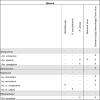Data release: targeted systematic literature search for tick and tick-borne pathogen distributions in six countries in sub-Saharan Africa from 1901 to 2020
- PMID: 38389097
- PMCID: PMC10885379
- DOI: 10.1186/s13071-023-06086-4
Data release: targeted systematic literature search for tick and tick-borne pathogen distributions in six countries in sub-Saharan Africa from 1901 to 2020
Abstract
Background: Surveillance data documenting tick and tick-borne disease (TBD) prevalence is needed to develop risk assessments and implement control strategies. Despite extensive research in Africa, there is no standardized, comprehensive review.
Methods: Here we tackle this knowledge gap, by producing a comprehensive review of research articles on ticks and TBD between 1901 and 2020 in Chad, Djibouti, Ethiopia, Kenya, Tanzania, and Uganda. Over 8356 English language articles were recovered. Our search strategy included 19 related MeSH terms. Articles were reviewed, and 331 met inclusion criteria. Articles containing mappable data were compiled into a standardized data schema, georeferenced, and uploaded to VectorMap.
Results: Tick and pathogen matrixes were created, providing information on vector distributions and tick-pathogen associations within the six selected African countries.
Conclusions: These results provide a digital, mappable database of current and historical tick and TBD distributions across six countries in Africa, which can inform specific risk modeling, determine surveillance gaps, and guide future surveillance priorities.
Keywords: Chad; Djibouti; Ethiopia; Kenya; Systematic review; Tanzania; Tick-borne pathogens; Ticks; Uganda.
© 2024. This is a U.S. Government work and not under copyright protection in the US; foreign copyright protection may apply.
Conflict of interest statement
The authors have no conflicts of interest to declare.
Figures










Similar articles
-
Tick-Borne Diseases in Sub-Saharan Africa: A Systematic Review of Pathogens, Research Focus, and Implications for Public Health.Pathogens. 2024 Aug 17;13(8):697. doi: 10.3390/pathogens13080697. Pathogens. 2024. PMID: 39204297 Free PMC article.
-
Geographical distribution of ixodid ticks and tick-borne pathogens of domestic animals in Ethiopia: a systematic review.Parasit Vectors. 2022 Mar 28;15(1):108. doi: 10.1186/s13071-022-05221-x. Parasit Vectors. 2022. PMID: 35346354 Free PMC article.
-
Distribution of ticks in the Western Palearctic: an updated systematic review (2015-2021).Parasit Vectors. 2023 Apr 24;16(1):141. doi: 10.1186/s13071-023-05773-6. Parasit Vectors. 2023. PMID: 37095583 Free PMC article.
-
Major vectors and vector-borne diseases in small ruminants in Ethiopia: A systematic review.Acta Trop. 2017 Jun;170:95-104. doi: 10.1016/j.actatropica.2017.02.015. Epub 2017 Feb 14. Acta Trop. 2017. PMID: 28212848
-
Prevalence of tick-borne pathogens in Rhipicephalus species infesting domestic animals in Africa: A systematic review and meta-analysis.Acta Trop. 2023 Oct;246:106994. doi: 10.1016/j.actatropica.2023.106994. Epub 2023 Jul 27. Acta Trop. 2023. PMID: 37516420
Cited by
-
Tick-Borne Diseases in Sub-Saharan Africa: A Systematic Review of Pathogens, Research Focus, and Implications for Public Health.Pathogens. 2024 Aug 17;13(8):697. doi: 10.3390/pathogens13080697. Pathogens. 2024. PMID: 39204297 Free PMC article.
-
Bibliometric analysis for the identification of main limitations and future directions of vaccines for the control of ticks and tick-borne pathogens in Uganda.Curr Res Parasitol Vector Borne Dis. 2024 Apr 18;5:100175. doi: 10.1016/j.crpvbd.2024.100175. eCollection 2024. Curr Res Parasitol Vector Borne Dis. 2024. PMID: 38689738 Free PMC article. Review.
-
Tick Diversity and Distribution of Pathogen in Ticks Collected from Wild Animals and Vegetation in Africa.Pathogens. 2025 Jan 25;14(2):116. doi: 10.3390/pathogens14020116. Pathogens. 2025. PMID: 40005493 Free PMC article. Review.
-
Nanopore sequencing reveals a diversity of microorganisms in ticks from Ethiopia.Parasitol Res. 2025 Jun 30;124(7):73. doi: 10.1007/s00436-025-08520-1. Parasitol Res. 2025. PMID: 40586794 Free PMC article.
-
A systematic review of ticks and tick-borne pathogens of cattle reared by smallholder farmers in South Africa.Curr Res Parasitol Vector Borne Dis. 2024 Jul 27;6:100205. doi: 10.1016/j.crpvbd.2024.100205. eCollection 2024. Curr Res Parasitol Vector Borne Dis. 2024. PMID: 39258000 Free PMC article. Review.
References
Publication types
MeSH terms
Grants and funding
LinkOut - more resources
Full Text Sources
Medical
Miscellaneous

